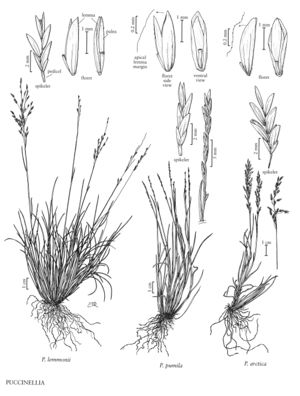Difference between revisions of "Puccinellia lemmonii"
FNA>Volume Importer |
imported>Volume Importer |
||
| (8 intermediate revisions by 2 users not shown) | |||
| Line 17: | Line 17: | ||
-->{{Treatment/Body | -->{{Treatment/Body | ||
|distribution=Wash.;Calif.;Oreg.;Mont.;Wyo.;Idaho;Nev. | |distribution=Wash.;Calif.;Oreg.;Mont.;Wyo.;Idaho;Nev. | ||
| − | |discussion=<p>Puccinellia lemmonii grows in non-littoral saline environments in the western portion of the contiguous United States. Reports from Saskatchewan are probably based on depauperate specimens of P. nuttalliana.</p> | + | |discussion=<p><i>Puccinellia lemmonii</i> grows in non-littoral saline environments in the western portion of the contiguous United States. Reports from Saskatchewan are probably based on depauperate specimens of <i>P. nuttalliana</i>.</p> |
|tables= | |tables= | ||
|references= | |references= | ||
| Line 26: | Line 26: | ||
-->{{#Taxon: | -->{{#Taxon: | ||
name=Puccinellia lemmonii | name=Puccinellia lemmonii | ||
| − | |||
|authority=(Vasey) Scribn. | |authority=(Vasey) Scribn. | ||
|rank=species | |rank=species | ||
| Line 33: | Line 32: | ||
|basionyms= | |basionyms= | ||
|family=Poaceae | |family=Poaceae | ||
| + | |illustrator=Cindy Roché | ||
| + | |illustration copyright=Utah State University | ||
|distribution=Wash.;Calif.;Oreg.;Mont.;Wyo.;Idaho;Nev. | |distribution=Wash.;Calif.;Oreg.;Mont.;Wyo.;Idaho;Nev. | ||
|reference=None | |reference=None | ||
| Line 38: | Line 39: | ||
|publication year= | |publication year= | ||
|special status= | |special status= | ||
| − | |source xml=https:// | + | |source xml=https://bitbucket.org/aafc-mbb/fna-data-curation/src/200273ad09963decb8fc72550212de541d86569d/coarse_grained_fna_xml/V24/V24_675.xml |
|subfamily=Poaceae subfam. Pooideae | |subfamily=Poaceae subfam. Pooideae | ||
|tribe=Poaceae tribe Poeae | |tribe=Poaceae tribe Poeae | ||
Latest revision as of 16:24, 11 May 2021
Plants perennial; cespitose, not mat-forming. Culms 5-40 cm, usually erect. Leaves basally concentrated; ligules 0.8-2.2 mm, obtuse to acute, mostly entire, sometimes slightly erose; blades involute, 1.2-1.9 mm wide when flattened. Panicles 2-18 cm, compact to diffuse at maturity, lower branches ascending to descending, usually spikelet-bearing to the base; pedicels scabrous, lacking tumid epidermal cells. Spikelets 3.5-8 mm, with 2-6 florets. Glumes rounded over the back, veins obscure, apices acute to obtuse; lower glumes 0.7-1.5 mm; upper glumes 1.4-3 mm; calluses with a few hairs; lemmas 2.4-4 mm, herbaceous, mostly smooth, usually glabrous, sometimes with a few hairs near the base, principally along the veins, backs usually rounded, sometimes weakly keeled distally, 5-veined, veins obscure, midveins often slightly scabrous and prominent in the distal 1/2, often extending to the apical margins, lateral veins not extending to the margins, apical margins ranging from smooth to scabrous, entire, not white, apices acute, entire; palea veins glabrous or shortly ciliate proximally, uniformly scabrous distally; anthers 1-2 mm. 2n = 14.
Distribution
Wash., Calif., Oreg., Mont., Wyo., Idaho, Nev.
Discussion
Puccinellia lemmonii grows in non-littoral saline environments in the western portion of the contiguous United States. Reports from Saskatchewan are probably based on depauperate specimens of P. nuttalliana.
Selected References
None.
